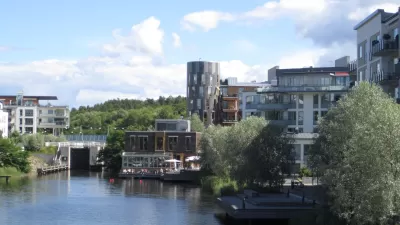Despite spending millions on urban renewal projects, municipalities often miss a common group of opportunities to make their communities more livable and walkable, according to William Adams, a San Diego-based land use attorney.

When it comes to urban renewal, understanding the “big picture” is not enough to keep cities and towns from making mistakes.
William Adams, a San Diego-based land use attorney, writes that despite the increasing success of urban renewal in the past 15 years, cities are still missing opportunities to veer away from the auto-orientation that is driving suburbanites to city centers. (Please excuse the auto-oriented idioms.)
Common mistakes include communities not knowing how to truly provide for pedestrians and other active transit users, according to Adams.
“The lesson: Pedestrians and active transit users need routes designed specifically for them, not simply as an add-on to routes designed for cars. Route planning should seek shortcuts and other opportunities that give walking or biking advantages over the automobile.”
Other common errors include not selecting the right streetscape trees, not reducing parking, and not protecting existing building stock.
“..for more than any other reason, successful urban renewal depends on creating or restoring an environment that diminishes the primacy of the automobile and prioritizes walking, active transit, public transit, the natural environment, and existing structures.”
FULL STORY: 6 Common Mistakes Made By Cities and Towns in Urban Renewal

Planetizen Federal Action Tracker
A weekly monitor of how Trump’s orders and actions are impacting planners and planning in America.

Maui's Vacation Rental Debate Turns Ugly
Verbal attacks, misinformation campaigns and fistfights plague a high-stakes debate to convert thousands of vacation rentals into long-term housing.

Restaurant Patios Were a Pandemic Win — Why Were They so Hard to Keep?
Social distancing requirements and changes in travel patterns prompted cities to pilot new uses for street and sidewalk space. Then it got complicated.

In California Battle of Housing vs. Environment, Housing Just Won
A new state law significantly limits the power of CEQA, an environmental review law that served as a powerful tool for blocking new development.

Boulder Eliminates Parking Minimums Citywide
Officials estimate the cost of building a single underground parking space at up to $100,000.

Orange County, Florida Adopts Largest US “Sprawl Repair” Code
The ‘Orange Code’ seeks to rectify decades of sprawl-inducing, car-oriented development.
Urban Design for Planners 1: Software Tools
This six-course series explores essential urban design concepts using open source software and equips planners with the tools they need to participate fully in the urban design process.
Planning for Universal Design
Learn the tools for implementing Universal Design in planning regulations.
Heyer Gruel & Associates PA
JM Goldson LLC
Custer County Colorado
City of Camden Redevelopment Agency
City of Astoria
Transportation Research & Education Center (TREC) at Portland State University
Jefferson Parish Government
Camden Redevelopment Agency
City of Claremont


























